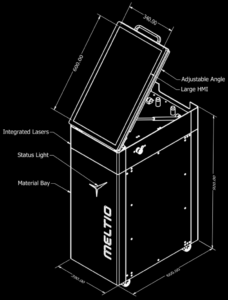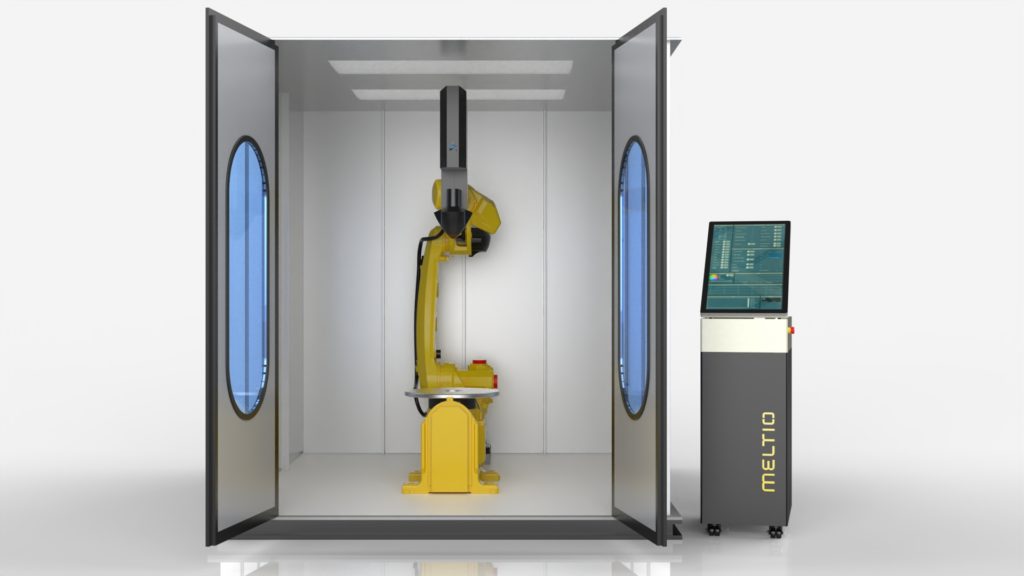ADDiTEC, a Florida-based metal additive manufacturing (AM) and automation services firm, announced that the company has launched a new fully-automated production cell, the Additive Manufacturing Robot Cell – Portable (AMRC – P). ADDiTEC is touting the AMRC – P as the world’s first portable AM robot cell created for reactive metals like titanium.
Established in 2015, ADDiTEC co-founded the MELTIO brand of metal AM platforms in 2019 with Spanish company SicNova 3D, and is the main distributor of MELTIO in North America. MELTIO systems are designed for producing large parts, utilizing ADDiTEC’s patented laser metal deposition – wire powder (LMD-WP) process. As the name implies, LMD-WP combines compatibility for both metal wire and powders into a single machine.

The AMRC – P takes the concept of multifunctional even further with the addition of a robotic arm, welded — along with the printer — into a portable cell. Moreover, in spite of its portability, ADDiTEC notes that the system is capable of producing parts up to almost two meters in dimension.
In turn, the system could be ideal for heavy industrial applications that need to take place on-site in remote locations. This suggests that the platform could attract attention, most immediately, from the defense and oil & gas sectors. Given the current dynamics shaping the AM market, then, this release is perfectly-timed. In the press statement for the AMRC-P, ADDiTEC’s business manager confirmed that the catalyst behind the new hybrid platform was “strong demand in the market” for a portable production cell at a relatively low price point.

Regardless of any particular sales numbers, I can at least confirm, having attended ASTM’s International Conference on Additive Manufacturing (ICAM) in Orlando last week, that the discussion and optimism surrounding hybrid production cells seems to be growing. Whether it was automotive (GM), aviation (GKN Aerospace), or information networks and industrial production (Siemens), there seems to be implicit agreement among those working on the engineering side of things that AM’s primarily role in industry will be its centrality to digital manufacturing ecosystems, rather than its potential as a standalone technology.
If anything, I believe that will generally elevate, not diminish, the value of AM platforms. Simply put, a strong consensus may still be lacking, concerning the feasibility of a transition to additive over the next decade.
Yet no one focused on the issues involved seems to doubt that a broad-sweeping shift to advanced manufacturing is happening, and that it will be required to happen even more quickly over the next few years. That is the bare minimum, in order for the wide range of long-term socioeconomic goals being set by global policymakers to even partially succeed. Since this is the case, it is only a matter of time before similar agreement emerges that, although it will never be able to replace conventional manufacturing on its own, AM is still the linchpin amongst all the various technologies that need to rapidly scale up, in order for manufacturing to evolve as it must.
Subscribe to Our Email Newsletter
Stay up-to-date on all the latest news from the 3D printing industry and receive information and offers from third party vendors.
You May Also Like
Stratasys Buys Arevo’s Carbon Fiber 3D Printing Assets
In its first major move since the year began, Stratasys Ltd. (Nasdaq: SSYS) has announced the acquisition of Arevo Inc.’s technology portfolio, marking a strategic expansion of its capabilities in...
Everything Must Go? Arevo’s 3D Printing Assets up for Auction
Arevo was among the first startups to develop a method for continuous carbon fiber 3D printing at large scales. With investments from Khosla Ventures and In-Q-Tel, among others, the Silicon...
Flexible Wireless Temperature Sensor Made with 3D Printing
Researchers from the University of Glasgow, University of Southampton, and Loughborough University have developed an innovative flexible temperature sensor utilizing microwaves and 3D printing technology. As detailed in an article...
3D Printing News Briefs, January 6, 2024: Digital Spares, Interbody Implants, Shoes, & More
In today’s 3D Printing News Briefs—the first of the new year!—we’ll start with metal 3D printing and move on to software and digital spares. Then it’s on to medical news...






























